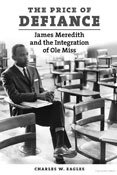To determine whether or not to read a new book of history, examine the footnotes. If the notes reference previous books and journal articles, you've got a rehash. If, on the other hand, the notes cite correspondence among the principals, interviews and documents from unpublished archives, then you know you've got a book that might open new doors. Put "The Price of Defiance: James Meredith and the Integration of Ole Miss," (University of North Carolina Press, 2009, $35) by Charles Eagles squarely in thelatter group.
Eagles places the events of the fall of 1962 into the context of the times. He spends the first 198 pages taking us from the founding of Ole Miss in 1848 to the end of the 1950s. His narrative description of the years leading up to 1960 should be required reading for every Mississippi high school senior. Studying them helps clarify why the riot at Ole Miss happened. Eagles is nothing if not succinct: "In 1960 the university represented for whites one of the few remaining redoubts of the glories of the Old South. Ole Miss stood for the nobility of the Lost Cause, the honor of Confederate veterans, and the gentility of the state's landed aristocracy." Only another war would overcome these obstacles to justice for black Mississippians.
Eagles rescues from historical oblivion Charles Dubra's and Medgar Evers' attempts to enter the Ole Miss Law School in 1953 and 1954, and Clennon King's failed effort to enroll in the university in 1958, as well as the nearly unbelievable tale of Will Campbell and Religious Emphasis Week at Ole Miss during 1955-1956. He also devoted a well-deserved chapter to Ole Miss history professor James W. Silver, who was told once by a colleague to "face the fact that you aren't going to save the soul of the South in your time." Silver may not have saved the "soul," but he wrote the best book about it yet written "Mississippi: The Closed Society."
Part Two of Eagles' book concentrates on Meredith, his background, his reasons for attempting the near impossible and his early skirmishes. Part three examines the days leading up to and after the riot. Eagles' account of this calamitynuanced, fully researched, comprehensive and written in a way that conveys the immediacy of the eventsis the best, yet.
Near the end of the book, I wondered if Eagles would end with his opinion of the monument honoring Meredith Ole Miss erected several years ago, which contains both a statue of Meredith and a memorial. A small plaque at the base of the statue reads: "James Meredith, a Mississippi native of Kosciusko, stepped into the pages of history on October 1, 1962 when he opened the doors to higher education at the University of Mississippi and in the South. As a major figure in the American civil rights movement, he helped lead the way to justice and equality for all citizens."
As Eagles points out, "In small letters difficult for an adult to read from a standing position, the marker fails to explain that Meredith was the African American who had desegregated Ole Miss." A short walk from the statue is a four-sided memorial. The words "Opportunity, Courage, Perseverance and Knowledge" each cap one of the four headstones. Missing, as Eagles once again points out, are fear, freedom, equality. and justice, words more synonymous with the Civil Rights Movement: "The words on the monument conveyed love for and pride in Mississippi. But what was left unsaid spoke more eloquently of what had not changed and what remained to be done."
Previous Comments
- ID
- 152280
- Comment
I took dr. eagles's civil rights class at Ole Miss, and he was an excellent teacher. I am pleased and not at all surprised to hear that this book is well researched and cogently written. Do you know how I can purchase the book?
- Author
- Lindsey
- Date
- 2009-09-24T10:54:48-06:00



Comments
Use the comment form below to begin a discussion about this content.
comments powered by Disqus